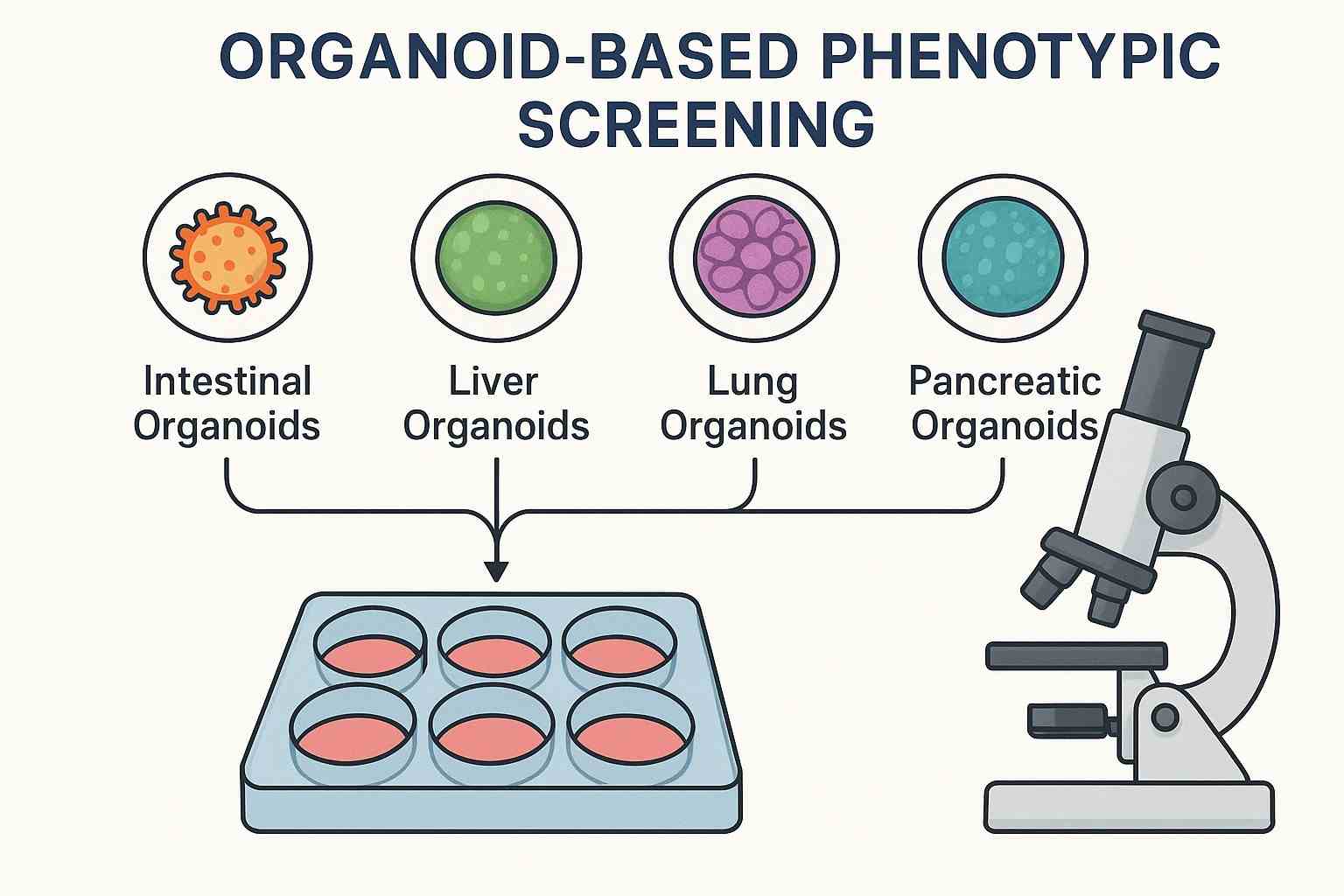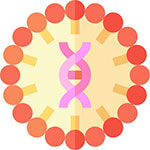Organoid-Based Phenotypic Screening
INQUIRYBOC Sciences, leveraging its advanced organoid technology platform, has developed a systematic phenotypic screening service that comprehensively covers key stages such as early drug discovery, mechanism research, personalized medicine, and toxicity assessment. We possess a rich repository of patient-derived organoid (PDO) models, a multi-organ organoid biobank, as well as high-throughput screening and high-content imaging capabilities, enabling highly accurate simulation of complex disease microenvironments and multidimensional phenotypic analysis. Through flexible and customized screening strategies and data analysis systems, BOC Sciences provides customers with efficient, precise, and translational organoid-based drug screening solutions.

Service Highlights and Advantages
- High-throughput screening capability: 384-well plate format, processing >1,000 compounds in a single run, suitable for large-scale screening.
- Rich model types: covering 20+ types of organoids, applicable to drug screening for more than 10 common cancers.
- High-resolution imaging: confocal system with 2048×2048 resolution, precisely capturing 3D structural phenotypes.
- AI image analysis: deep learning to identify >30 parameters, extracting key features such as volume and apoptosis.
- Customized screening schemes: flexible selection of organoid source, dosage, and endpoints, supporting mechanism studies.
- Multidimensional endpoint readouts: covering morphology, fluorescence, protein expression, and other indicators for systematic evaluation of efficacy and toxicity.
Organoid-Based Phenotypic Screening Services from BOC Sciences
The organoid phenotypic screening platform developed by BOC Sciences integrates organoid culture techniques, high-content screening (HCS) systems, automated liquid handling, and AI-driven data analysis algorithms to provide a complete service workflow from model construction to compound screening and mechanism validation.
Multi-Organ Organoid Screening Library (Organoid Biobank)
- Includes organoid libraries covering the digestive, respiratory, urinary, and nervous systems, as well as various solid tumors.
- Organoid models in the library include those derived from liver, intestine, lung, stomach, pancreas, kidney, prostate, and other organs or tissues.
- All organoid models are molecularly characterized to ensure data comparability and model stability.
- Normal tissue-derived organoids can be used for toxicity evaluation and selectivity testing.
Personalized Compound Library Design and Screening
- Based on the client's target pathway or mechanism, we assist in customizing exclusive small molecule or natural product libraries.
- Literature analysis and database-integrated screening can be conducted based on specific targets, structural features, and functional categories.
- Screening support is available for various library sizes (small:<500; medium:="" large:="">5000 compounds).
- Integrated screening and mechanism validation workflows can be conducted using organoid models.
- Screening outputs include detailed phenotypic change data, IC50 calculations, selectivity index, and more.
High-Throughput 3D Screening
- We are equipped with advanced automated high-throughput screening systems (HTS).
- High-precision automated liquid handling.
- Standardized construction of 3D organoid culture systems.
- High-content screening systems (HCS) for image acquisition and analysis.
- Multi-parameter phenotypic readouts (e.g., morphology, fluorescent labeling, cell death, DNA damage, etc.).
Toxicology Screening and Safety Evaluation
- Use of normal tissue-derived organoids (e.g., liver, intestinal, kidney organoids) as models to evaluate the toxicity response of candidate drugs.
- Multi-parameter toxicity assessment indicators: decreased cell viability, induced apoptosis, tissue damage, metabolic disorders, etc.
- Capable of studying acute toxicity, chronic exposure models, dose-response relationships, and time-dependent effects.
- Comparative analysis with tumor organoids provided to calculate therapeutic window and selective toxicity index.
- Transcriptomics and proteomics analysis can be combined to investigate toxicity-related pathways and targets, supporting early candidate optimization.
Do You Need A Consultation?
BOC Sciences integrates innovative technologies to empower your drug discovery with strong momentum, fully dedicated to building next-generation drug screening platforms.
Comprehensive Organoid Library for Phenotypic Screening
BOC Sciences has established a fully functional organoid model library covering multiple tissue origins, including the digestive, respiratory, nervous, and urinary systems, involving various disease types such as liver cancer, lung cancer, breast cancer, pancreatic cancer, colorectal cancer, and neurodegenerative diseases. The platform integrates PDO, induced pluripotent stem cell (iPSC)-derived organoids, and normal tissue-derived models to meet diverse screening needs such as efficacy evaluation, toxicity analysis, and personalized drug response studies, widely applicable to oncology, rare diseases, and precision medicine.
| Organoid Type | Source Tissue | Applicable Disease Areas |
|---|---|---|
| Intestinal Organoids | Small intestine, colon, rectum | Inflammatory bowel disease, colorectal cancer, intestinal infections |
| Liver Organoids | Liver tissue or iPSC-induced | Drug metabolism toxicity, liver cancer, viral hepatitis |
| Lung Organoids | Bronchial and alveolar cells | Lung cancer, pulmonary fibrosis, COVID-19 |
| Brain Organoids | iPSC-induced neurons | Alzheimer's disease, Parkinson's disease, brain tumors |
| Pancreatic Organoids | Pancreatic acinar cells | Pancreatic cancer, diabetes models |
| Prostate/Breast Organoids | Human tissue slices | Hormone-dependent tumor drug screening |
| Gastric Organoids | Gastric epithelial stem cells or gastric cancer tissue | Gastritis, gastric ulcer, Helicobacter pylori infection, gastric cancer |
| Kidney Organoids | iPSCs or kidney tissue samples | Tubular injury, diabetic nephropathy, polycystic kidney disease, kidney cancer |
| Skin Organoids | Co-culture of keratinocytes and dermal fibroblasts | Psoriasis, atopic dermatitis, burn repair, skin cancer |
| Uterus and Ovary Organoids | Reproductive tract tissues or stem cells | Endometriosis, ovarian cancer, polycystic ovary syndrome |
| Heart Organoids | Cardiac stem cells or iPSC differentiation | Arrhythmia, cardiomyopathy, drug-induced cardiotoxicity evaluation |
Project Workflow

Project Requirement Assessment and Technical Communication
At the initial stage of the project, we will engage in in-depth discussions with clients to clarify the research objectives for drug screening, the types of targeted diseases, compound categories, and expected phenotypic endpoints. We will assist clients in evaluating the availability or feasibility of customizing the required organoid models, and preliminarily develop a screening plan and project timeline.

Organoid Model Preparation and Quality Verification
Based on project requirements, we construct or introduce various types of organoid models derived from patients or stem cells. After model establishment, we perform morphological assessments, marker expression analysis, and functional tests to verify their similarity to real tissues and biological activity, ensuring that the models meet quality standards and provide reproducibility and predictability for drug screening.

Phenotypic Screening Program Design
Based on drug properties and screening objectives, we formulate a scientifically sound screening protocol, including drug concentration settings, treatment duration, plate formats, endpoint indicators, and control conditions. We support personalized designs, such as combination therapies, dose-dependency, and time-gradient experiments to accommodate different drug mechanisms and research depth requirements.

Automated Drug Handling and Image Acquisition
With automated liquid handling systems, we achieve precise dosing and high-throughput screening. After treatment, multi-channel fluorescence images of the organoids are collected using a high-content screening system, capturing their morphological changes, physiological states, and phenotypic responses to build a high-quality image dataset that provides visual evidence for subsequent analyses.

Phenotypic Image Analysis and Multidimensional Data Interpretation
We utilize artificial intelligence and image recognition technologies to quantitatively analyze organoid images, extracting key features such as volume, roundness, structural integrity, and fluorescence signals. Using principal component analysis (PCA), clustering algorithms, and statistical methods, we reveal phenotypic changes and underlying mechanisms induced by drugs from multiple dimensions.

Report Writing and Delivery
BOC Sciences will provide clients with a comprehensive data analysis report, including experimental design, organoid characteristics, drug response curves, image presentations, and statistical results. Upon request, raw data files, analytical charts, and image resources can be included. We also offer suggestions for follow-up mechanistic studies to support the screening and validation of candidate compounds.
Applications of Organoid-Based Phenotypic Screening
Anti-Tumor Drug Screening and Target Validation
Organoids can highly simulate the three-dimensional structure and genetic mutation characteristics of tumor tissues, making them suitable for screening chemotherapy drugs, targeted agents, and immunotherapies for various cancer types. By monitoring phenotypic changes such as proliferation inhibition, apoptosis induction, and stemness elimination, candidate drug activity evaluation and preliminary mechanism validation can be achieved, accelerating the discovery and optimization of new anti-cancer drugs.
Personalized Medicine and Precision Therapy
Organoids can be directly constructed from patient tissues, retaining individual tumor or tissue genetic backgrounds and drug sensitivity differences. By conducting drug phenotypic screening on patient-specific organoids, responses to various treatment regimens can be predicted, providing personalized medication references for clinicians and serving as a key technological support for precision medicine strategies.
Rare and Genetic Disease Model Research
For rare genetic disorders or congenital metabolic diseases, organoids can be constructed as pathological models via stem cell induction or gene editing. Drug phenotypic screening on these models helps identify potential therapeutic candidates, especially in disease areas lacking animal models or clinical samples, providing efficient solutions for orphan drug development.
Toxicology and Safety Assessment
Organoids structurally and functionally resemble in vivo tissues more closely, and can be used to assess toxicity in organs such as the liver, kidney, and heart, addressing the limitations of traditional 2D cell models. Observing phenotypic changes like apoptosis, injury markers, and metabolic enzyme expression supports early identification of drug toxicity risks and optimization of candidate compound screening criteria.
FAQs
What is organoid phenotypic screening?
Organoid phenotypic screening is a drug effect evaluation method performed in 3D organoids. It identifies lead compounds with therapeutic potential by observing morphological changes, growth, apoptosis, and other reactions through multidimensional endpoints.
What types of organoid models can BOC Sciences provide?
We offer a wide range of organoid models, covering more than 20 types including liver, lung, intestine, brain, and breast. These include both healthy donor-derived models and patient-derived organoids (PDOs) as well as hiPSC-induced models.
What is your screening scale and throughput?
Our platform supports screening in 96-well and 384-well formats. A single experiment can evaluate over 1,000 compounds, making it suitable for large-scale primary screening and candidate compound selection.
Can you support custom experimental plans for clients?
Absolutely. We support customization based on client needs, including organoid type, drug concentration gradients, endpoint readouts, and data analysis strategies, flexibly adapting to different research goals and development stages.
What types of endpoint readouts can you provide?
We offer endpoint readouts such as morphological changes, volume measurements, fluorescence marker expression, apoptosis levels, and reactive oxygen species, enabling multidimensional analysis of drug mechanisms and toxicity profiles.
Do you have automated imaging and AI analysis capabilities?
Yes. Our platform is equipped with confocal high-content imaging systems and AI-based image analysis software, capable of automatically identifying over 30 phenotypic parameters to deliver fast, objective, and highly reproducible data analysis.
Can you support screening with patient-derived organoids (PDOs)?
Yes. We have established a PDO model library of over 100 cases and support clients in providing fresh tissue samples to construct individualized organoids for drug efficacy prediction, drug resistance studies, and personalized therapy evaluation.
Online Inquiry

